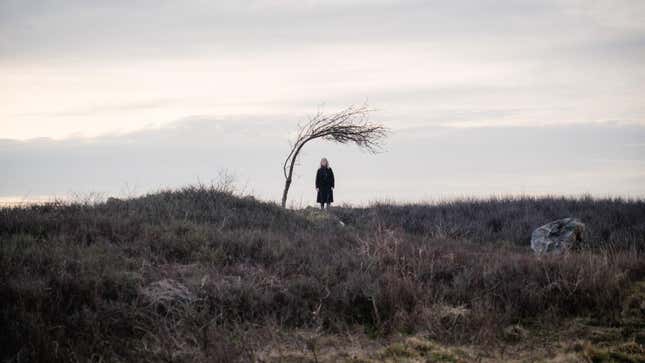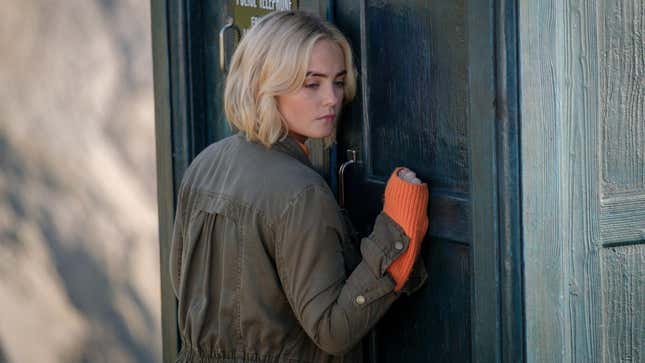The latest era of Doctor Who has been all over the place—from festive fantasy, to madcap sci-fi silliness, to jauntily uneven camp, and to anti-capitalist wartime thrillers. But its latest juke lands itself somewhere familiar but entirely new for the series, and finally decides to give Millie Gibson’s Ruby Sunday the spotlight to show what she’s capable of. And boy howdy, did it put her through it.
“73 Yards” is, perhaps, the Steven Moffat episode fans looking forward to last week’s Steven Moffat episode were expecting before they got their socks proverbially knocked off by “Boom”—another twist in this season’s overall vibe with playing with the very foundations and expectations of storytelling. With Russell T Davies back in the writer’s seat, this time we’re pulled back to the UK in the modern day, as the Doctor and Ruby land in Wales and immediately find themselves thrust into a deeply creepy tale that gives Ruby her opportunity to really show the audience what she’s made of. We got some of that last week in “Boom” of course, but “73 Yards” takes it a step further by, not even five minutes into its runtime, completely removing the Doctor from the situation, as the duo encounter a strange ritualistic circle of folk charms and messages that, as Ruby reads one aloud, sees the Doctor suddenly vanish from beside her side… and off in the distance, a strange, out of focus elderly woman watches her, never coming closer, never getting further away, but always gesturing, always signing something, but rather, finding fear for the audience and Ruby alike in merely existing.

This is no longer the case of Ruby having to prove herself to someone, or show that she can match her mysterious new friend on an even standing, as it was in “Boom” with the Doctor rooted in one place. She can’t get close enough to the woman to communicate with her, or find out what she wants, and any attempts she tries to make through a third party—other people can see her, but don’t really notice the distant woman until Ruby points her out—to make contact leads to the woman sending them screaming away from Ruby in terror and disgust. So, Doctor Who asks, even this early into her time with the Doctor, what is Ruby’s mettle made of when she can’t rely on him to be there at all?
What follows is both an incredibly chilling ghost tale—one where everyone can actually kind of see the ghost—but also a chance for Davies to deliver something in Doctor Who that feels a little closer to his post-Who career after leaving the show in 2009, especially in the vein of his near-future political drama Years and Years. Through Ruby, and through this mysterious woman’s ability to essentially get people to somehow suddenly sour on Ruby the second they make close contact, Davies raises an absurdist mirror to modern Britain, and sees how much ugliness is hidden just beneath the surface—and how it doesn’t necessarily need a supernatural entity to bring it bubbling up. Really, the fear of “73 Yards” is not the creep factor of this woman perpetually being the titular distance from Ruby, but the utter loneliness and isolation her power imparts on Ruby over and over. But that loneliness is twisted even further and more potently by the bitterness it leaves in its wake.

First the Doctor goes, leaving Ruby stranded in a tiny Welsh village, where cold, bitter locals gaslight the outsider with tales of an ancient spirit named “Mad Jack” and the real power behind the circle Ruby and the Doctor came across, eventually forcing her out, despite her having no real place to go with the Doctor lost and the TARDIS locked down. When Ruby heads home to London to her mother, Carla not only finds herself afflicted by the mysterious woman’s powers, but amplifies them by not just running away from Ruby, but returning, locking her out of her own home, and then cruelly slinging barbs and insults over her birth mother to push Ruby away even further. Even, years later—scraping by in a dead-end job to make ends meet, utterly cut off—a chance encounter with Kate Lethbridge Stewart and UNIT leads to this one moment of hope, that the Doctor’s world and her association with it could save her, is lost when, for all their own psychic and supernatural safeguards, they too are turned against Ruby, leaving her distraught and ostracized by the passers-by witnessing her breakdown—not the armed police units that just charged through a busy street and then immediately fled, but because this young, distressed woman is brushing up against that stiff-upper reserved nature of public British culture.
It’s here that “73 Yards” really takes its biggest step to feeling like a Doctor Who spin on Years and Years’ treatise on the UK. As the literal years and years pass, told through a montage of Ruby losing boyfriend after boyfriend as they all chastise her for seeming distant and distracted, as she’s unable to explain the supernatural phenomena causing it, Ruby eventually overhears a news broadcast that puts two offhand elements from early on in the episode together. An interview with an up and coming reactionary Welsh political leader Roger ap Gwilliam (Aneurin Barnard), who the Doctor had jokingly mentioned to Ruby upon landing in Wales as Britain’s future worst prime minister—Doctor Who could not have asked for better timing than to have this episode air days after the UK’s next general election was called—sees the politician call upon his working class background by invoking “Mad Jack” as an old nickname. With that, Ruby realizes that she has the chance to avoid the crushing loneliness she’s endured the past few years and go be in a Doctor Who story, with a villain to fight, a kernel of hope, a chance to make everything this mysterious entity has put her through seemingly for no reason into context.

Instead, it just takes ugliness Ruby has endured on a personal scale and brings it to a national one. Infiltrating ap Gwilliam’s political party, Albion, as a volunteer to get close to him, Ruby and the audience alike are instead exposed to this fascinatingly grim caricature of modern politics. Ap Gwilliam doesn’t have a laid-out manifesto or dream as a politician that’s made clear to us—both because this is an episode of Doctor Who rather than The Thick of It, and because also that’s the point—but he has an absurdly unhinged nationalist vibe. All that’s made clear to us about ap Gwilliam’s desire to lead the UK is to make it a bitter, isolated nation, backed by a comprehensive nuclear arsenal it would be unafraid to use at the drop of a hat. But instead of people questioning it, all we’re shown is that from within his party and beyond into the general populace, there is somehow a feverish yearning for such an evil desire. Other countries are cruel bullies, why not us too? Albion is sweeping the polls, as the Doctor warned, ap Gwilliam becomes Prime Minister handily, and yet all we know of his wants is mass nuclear destruction for little reason other than hate—and with that hate, he’s commanding the rapt attention of tens of thousands of bitter British citizens that want the world to notice them.
It’s only Ruby that sees ap Gwilliam for what he is—and eventually clicks that before he can lead Britain into a horrific new age, having purchased a huge nuclear arsenal for the country to deploy, she has to use the presence of the mysterious woman, and her supernatural fear induction, by standing 73 yards away from the now-leader of the UK and get her to work on him. “73 Yards” doesn’t immediately end there though, and it’s where the episode gets a little messy falling over itself in the wrap-up: there’s not some sudden snap-back as time corrects itself, that Ruby has saved the day and gets to be immediately rewarded with being back to normal. The mysterious woman might have been the tool she uses to stop ap Gwilliam, but it’s still there after he’s fled and resigned in sudden, fearful disrepute. She’s still isolated and cut off from the Doctor, and her family, and UNIT, and countless other people from the years of this entity’s existence alongside her, and still has to keep living. It’s only as we flash forward another 40 years to an elderly Ruby (now played by Amanda Walker)—and see that she’s had to live that life alone and be at peace with it, returning to Wales one last time to say goodbye to the Doctor and the overgrown TARDIS for good. Ruby did the right thing, but she still had to suffer terribly for it.

It’s then that the episode unveils its final twist: the entity itself was some paradoxical version of the older Ruby, who had to become her and face all that grief and ugliness in the first place, so she could be sent back to that moment Ruby and the Doctor came across the fairy circle in the first place and stop it from being disturbed. It’s here the episode takes a bit of a minor stumble. That supernatural loop is closed, sure—Mad Jack’s mysterious spirit, and whatever connection it had to ap Gwilliam, is left to rest, and the entity disappears as the Doctor and Ruby go off on whatever their adventure was going to be in the first place, left unseen. But we spend so little time with the older Ruby that a few things don’t quite click the way they did in the earlier beats of the episode. The political commentary about ap Gwilliam’s rise is kind of left to fall apart in the background—cut off by a single newscaster line in the background about Britain making a sudden pivot to kinder, nicer politics (the Government he left behind still bought all those nuclear missiles though, so how exactly kinder is left unknown!). Similarly, we largely quickly move on from the sudden twist about the entity’s true nature, left to vanish in whatever caused the close loop with little in the way to satisfyingly or emotionally build up its connection to Ruby’s part in that loop, leaving the episode’s ending feel a little too sudden for its own good.
These stumbles aside however, the real creepiness of “73 Yards” we’re left with as it ends is that Ruby has some vague remembrance of this avoided timeline—and with it, all the ugliness that was dredged up in the name of preventing it. An ugliness, that, for all we know, is still buried just underneath the surface, from the tiniest village, to the people we love most, to the general populace, waiting for anything to dredge it up into plain sight. A fitting fear for Doctor Who to leave us on through this twisted lens, perhaps—a creeping wariness that is perpetually just out of sight. Muddled as its conclusion might be, in making that fear just an inherent reflection of human nature, rather than some supernatural evil, might be one of the most compelling steps this new era of the show has taken so far.
New Doctor Who episodes premiere Fridays at 7 p.m. ET on Disney+, and will broadcast through the BBC iPlayer at the same time in the UK, at 12 a.m. local time on Saturdays before broadcasting on BBC One later that day.
Want more io9 news? Check out when to expect the latest Marvel, Star Wars, and Star Trek releases, what’s next for the DC Universe on film and TV, and everything you need to know about the future of Doctor Who.
Trending Products

Cooler Master MasterBox Q300L Micro-ATX Tower with Magnetic Design Dust Filter, Transparent Acrylic Side Panel…

ASUS TUF Gaming GT301 ZAKU II Edition ATX mid-Tower Compact case with Tempered Glass Side Panel, Honeycomb Front Panel…

ASUS TUF Gaming GT501 Mid-Tower Computer Case for up to EATX Motherboards with USB 3.0 Front Panel Cases GT501/GRY/WITH…

be quiet! Pure Base 500DX Black, Mid Tower ATX case, ARGB, 3 pre-installed Pure Wings 2, BGW37, tempered glass window

ASUS ROG Strix Helios GX601 White Edition RGB Mid-Tower Computer Case for ATX/EATX Motherboards with tempered glass…










